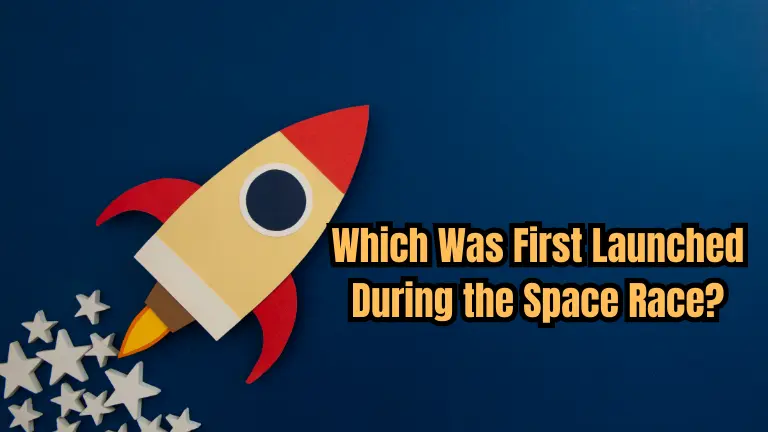The space race, a competition between the United States and the Soviet Union during the Cold War era, led to significant advancements in space exploration and technology. Both superpowers sought to demonstrate their technological prowess and ideological superiority.
In this article, we will explore Which Was First Launched During the Space Race? and discuss some of the groundbreaking achievements that emerged from this era.
Which Was First Launched During the Space Race?
The space race unfolded in the late 1950s and early 1960s and was characterized by a series of milestones that propelled humanity beyond Earth’s atmosphere. It was a time when the world witnessed remarkable feats in aerospace engineering, astrophysics, and astronautics. The technological progress achieved during this period laid the foundation for future space missions and expanded our understanding of the universe.
The Sputnik 1 Satellite
One of the most significant milestones of the space race was the launch of the Sputnik 1 satellite by the Soviet Union on October 4, 1957. Sputnik 1 was the first artificial satellite to orbit Earth, marking the beginning of the space age. This historic event sent shockwaves through the United States and the rest of the world, as it demonstrated Soviet technological superiority.
Sputnik 1 was a small, spherical spacecraft equipped with radio transmitters that broadcasted a simple “beep” signal. It completed an orbit around Earth every 96 minutes, providing valuable data on atmospheric density and the possibility of satellite-based communication. The launch of Sputnik 1 sparked a sense of urgency in the United States, leading to the establishment of NASA and significant investments in space exploration.
The Vostok 1 Spacecraft
On April 12, 1961, the Soviet Union achieved another major milestone by launching the Vostok 1 spacecraft, carrying Yuri Gagarin, the first human to journey into space. This momentous event captured the world’s attention and symbolized Soviet supremacy in space exploration. Gagarin’s flight lasted approximately 108 minutes, orbiting the Earth once before returning safely.
The Vostok 1 spacecraft was a cylindrical module with a pressurized cabin for the cosmonaut and essential life support systems. Gagarin’s successful mission paved the way for future manned spaceflights, demonstrating that human space travel was achievable. The Vostok 1 mission provided valuable insights into the effects of space travel on the human body and further fueled the competition between the United States and the Soviet Union.
The Apollo 11 Mission
Perhaps the most iconic achievement of the space race was the Apollo 11 mission, which resulted in the first manned Moon landing on July 20, 1969. Led by NASA, the United States successfully landed astronauts Neil Armstrong and Buzz Aldrin on the lunar surface while Michael Collins orbited above in the command module.
The Apollo 11 mission showcased the culmination of years of research, development, and testing. It involved the Saturn V rocket, a colossal spacecraft designed to carry humans to the Moon. Armstrong’s famous words, “That’s one small step for man, one giant leap for mankind,” echoed around the world and marked a monumental achievement for humanity.
This historic mission not only fulfilled President John F. Kennedy’s vision of landing humans on the Moon but also generated valuable scientific data and insights into lunar geology, the Moon’s origin, and the broader understanding of our universe. The Apollo program provided a platform for subsequent lunar missions and solidified the United States’ position as a leader in space exploration.
The Hubble Space Telescope
In 1990, the launch of the Hubble Space Telescope revolutionized our understanding of the universe. Operated by NASA and the European Space Agency (ESA), the Hubble Telescope is a powerful instrument that orbits Earth, capturing breathtaking images and collecting data from distant galaxies and celestial objects.
Equipped with advanced optics and sensors, the Hubble Telescope has allowed astronomers to observe phenomena that were previously inaccessible. Its observations have contributed to groundbreaking discoveries, including determining the age of the universe, identifying exoplanets, and providing insights into the formation and evolution of galaxies.
The Hubble Space Telescope serves as a testament to the collaborative efforts of scientists and engineers worldwide, pushing the boundaries of human knowledge and inspiring future generations of astronomers and astrophysicists.
The International Space Station (ISS)
The International Space Station (ISS) represents an extraordinary multinational endeavor in space exploration. Launched in 1998, the ISS is a habitable space station that serves as a laboratory for scientific research, technological advancements, and international cooperation.
The ISS is a joint project involving NASA, Roscosmos, ESA, and other international partners. It has provided a platform for experiments in various fields, including biology, physics, astronomy, and human physiology. The station’s continuous occupation by astronauts from different countries highlights the power of international collaboration in the pursuit of scientific knowledge.
The research conducted on the ISS has yielded crucial insights into the effects of long-duration space travel on the human body, which is essential for future manned missions to other celestial bodies. Moreover, the ISS serves as a symbol of unity, diplomacy, and cooperation among nations in the pursuit of scientific progress.
Conclusion
The space race, fueled by competition between the United States and the Soviet Union, led to groundbreaking achievements that shaped our understanding of space and technology. From the launch of the Sputnik 1 satellite to the Apollo 11 Moon landing, these milestones demonstrated humanity’s relentless pursuit of exploration and knowledge.
Today, we continue to build upon the foundations laid during the space race. Technological advancements, such as reusable rockets, improved satellite capabilities, and the potential for manned missions to Mars, inspire a new generation of scientists, engineers, and dreamers. The lessons learned from this era continue to drive our quest for further discoveries and the expansion of our cosmic horizons.
